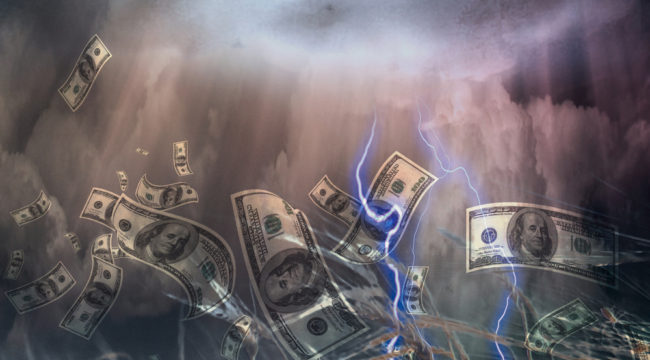Making Sense of a Weird Market
There’s a stock market crash coming.
Maybe.
It’s been a wild period in the markets. Between earnings season, increased tensions with North Korea and CEOs abandoning Trump after the Confederate statue controversy, investor anxiety has been on the rise.
That came to a head earlier this week when more than 90% of the stocks in the S&P 500 ended deep in the red. The tech-centric Nasdaq Composite plunged more than 2%.
The market was heavily down again yesterday. And as I write these words this morning, the major indexes are down again.
Needless to say, the big tail wind that’s been driving the broad market higher has tapered off.
Does that mean that the S&P is set to plunge now? No — it could turn around and tick higher, actually. But it does mean that we don’t have as clear a picture of what’s going to happen next in the big index.
But to be clear, there are some very good reasons why Mr. Market might be due to roll over.
Some very smart people — including some of my colleagues at Agora Financial — think that you have reason to be worried about owning stocks right now.
So where do I stand on that?
One of my readers, named Al, cuts to the chase with the following question:
Hi Jonas,
With all the Agora publications talking about a looming correction ahead — what’s your take on that and how should we play our positions to reduce risk, or will those positions be affected at all?
To start, let’s look at the first part of Al’s question — my take on all the correction and crash talk.
First off, we’re probably going to experience a stiff correction at some point in the not-so-distant future. It’s inevitable. But that’s not much of an insight.
And as to when it might happen — next week, next month, next year — your guess is as good as mine. Heck, it may have just started.
That’s not a cop-out answer.
It’s a way of thinking that could make you a more profitable trader than 99% of all other market participants. You see, it’s human nature to want to predict what’s going to happen next in the stock market.
There’s a reason why CNBC and all the other media outlets gather up all the stock market predictions from Wall Street strategists every year and rank how close they got to the final number at the end of the year. It makes for great TV. Easy ratings.
But don’t you think it’s kind of funny that CNBC never ranks those Wall Street talking heads by how much money they made their clients instead?
CNBC — and The Wall Street Journal, CNNMoney, etc. — are all fixated on who’s right. But they totally ignore the fact that there’s a difference between being right and making money.
And the way you make money in the markets is by identifying a consistently profitable system and then sticking to that that system — even when your gut is telling you that you should do something else.
Look, there are always going to be weird markets. The difference now is that I’ve got a unique tool in my arsenal that can help you actually make sense of them — and profit from them. As someone who’s been trading for a long time, that’s an exciting prospect!
That system is my Kinetic Profits strategy.
This proprietary system can identify a stock’s strongest periods year after year. It analyzes decades of price data to show when a stock is statistically most likely to be in motion — thus the “Kinetic” part of the name.
What makes this strategy unique is that we can see the buy signals coming.
In other words, it helps me figure out when a stock has a “tail wind.” But also importantly, when it doesn’t. That’s incredibly useful, especially at times like this.
Before I was ready to launch Kinetic Profits, my trading buddy Greg Guenthner helped me run a secret beta test of our K-Sign strategy early this year in his free newsletter, The Rude Awakening.
It was a sort of “proof of” concept.
In all, I sent him seven trades that were signaled by my unique system.
I didn’t call them “K-Signs” then — I hadn’t even given the signal a name yet at that point!
But I bring it up because the Kinetic Window recently closed on the seventh trade from the beta test. Simply put, all seven trades during the beta test were profitable.
All seven.
To put that into context, let’s assume the odds of picking a winning short-term trade randomly are similar to the odds of a coin flip (they aren’t, but they’re close enough to make my point). In that case, the odds are about 1,400-to-1 against hitting seven wins in a row by chance alone.
That’s exciting because it falls right in line with the 93.5% win rate generated by the back test data.
Only that seven-trade winning streak wasn’t a back test — it happened in real-time.
One huge benefit to using a quantitative, computer-based approach to trading is that my Kinetic system can constantly learn and improve as it gets more experience. And unlike a human, it doesn’t actually need to make mistakes to learn from them.
(I wish I could say the same for myself!)
The beta test was a useful experiment to fine-tune the strategy that we’re now using. And the outstanding real-world win rate is great validation for this trading system.
Consistently profitable doesn’t even begin to describe the results that the strategy has generated in more than a decade of back tests and in a real-world beta test conducted earlier this year.
Getting back to Al’s question, these tests give a very good preview of what risk looks like in the worst of conditions.
In 2008, for instance, my K-Sign strategy would have actually produced positive returns while the S&P 500 plunged. The median winning trade that year would have produced a 20% gain. That actually makes 2008’s winners some of the biggest — a result of the added volatility in the market that year.
Seeing that it was possible to survive 2008 profitably, I feel pretty confident about buying K-Signs as they trigger in any market conditions ahead.
Now, one interesting stat is that the win rate did decrease in 2008. “Only” about two-thirds of trades were profitable. That’s obviously more than most trading strategies can say in the best of years. But a reduced win rate might be an early warning sign that something is happening in the market structure.
I’ll let my readers know if that pattern starts to emerge again — but doesn’t look like it has so far. That can change, of course.
In the meantime, I’ll continue to rely on the data and ignore the noise in this market. You should too.
Regards,



Comments: